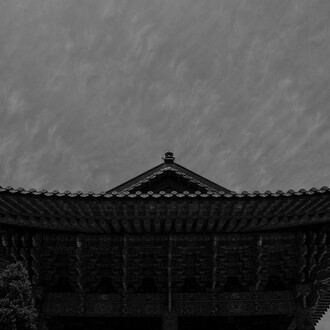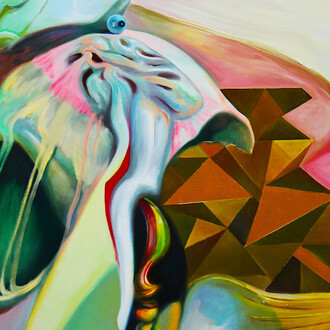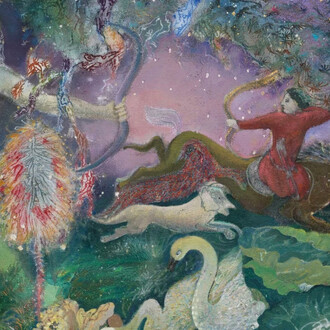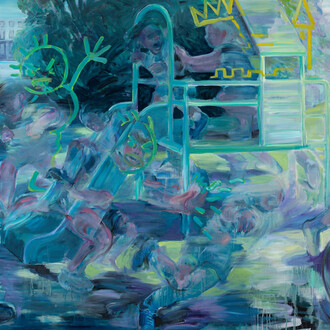Kate Oh Gallery is pleased to present A delicate theory of human chaos, a solo exhibition by Eun C. Kim. This exhibition offers an intimate exploration of the interplay between order and disorder, origins and loss, myth and modernity.
And the eyes of both of them were opened, and they knew that they were naked; so they sewed together fig leaves and made coverings for themselves.
(Genesis)
I say unto you: one must still have chaos in oneself to be able to give birth to a dancing star.
(Friedrich Nietzsche, Thus spoke Zarathustra)
In an idyllic universe, deep and impenetrable with cosmically flagellating foliage, where staves of light filter uneasily like creeping echoes of inhuman voices divorced of meaning, ether-oozing and impressible, a canvas is to be found that floats like the ten commandments in biblical density. Yet, it is an exquisitely constructed canvas whose very brushwork revels in organic serenity absent of cries and social raucousness, constructed of purity and reason. The artist could neither have posited a more macroscopically blurring beginning, nor a more encompassing thesis, cleanly stated like a uni-coloral palette.
Seemingly, this is an Eden of universal import and mythically self-contained as if in an ancient tome or a line of a Scholastic discourse. Nothing could argue against its strong and habitual rigor. But then, at the bottom of this philosophical world, a human figure appears, lying, maybe floating, like a wave amidst a green desert, like a sudden injection of a fabled possibility. The brushstrokes have changed within its small, univocal confines, becoming chaotic, rippling and evanescing, as if ejecting a thousand potentialities through its uncertainty of a brownish contour. The viewer is at once startled, unsure of the identity of this human or inhuman figure inside the green macrocosm.
Among Kim’s recent works, the work described above is Adam in the garden of Eden. On a not insubstantial 30 x 30in, acrylic, mixed media surface, the scenes offers a profound meditation on origins, loss, and perhaps, but just perhaps, a whisper of redemption. The background of the famous Genesis narrative has been transformed into a highly personal recount, at once subtle and elusive, where both the Tree of Life and the Tree of the Knowledge of Good and Evil are more suggestions than descriptions, never judgements. Hence, the entry of original sin into the condition of humanity appears not so much an allegory but a theoretical model of uncertainty, an opening chapter into a personalized theory of chaos.
For chaos, veritable and incongruously beauteous chaos, indeed offers the key to the main thesis of Eun Kim’s works: the interplay of universal flows of order and disorder, the boundless surprises of a world suffused with nonlinear dynamics. Like a double pendulum which exhibits intractable behavior in a laboratory, Eun Kim’s human figures come to life and vanish both inside and beyond the borders of her exquisitely autonomous paintings, as if to whisper this message to the connoisseur’s ear: In every organism that lives and maintains a workflow of orderly functioning, there are seeds of chaos, just like the dancing star Nietzsche birthed into the world through his Zarathustra.
The mysterious interchange never ceases to surprise us. In some ways, the brushstrokes that distinguish and demarcate the Edenic foliage from the chaos of the human figure are stark and virulent. The flatness of the green, against the jaggedness of the reddish brown. These seem to derive from absolutely incongruent elements--yet they cohere, both internally and externally, within the painting's lyrical boundaries, as well as outside its indomitable possibilities not depicted on canvas but resonant in the viewer's secret imagination.
Therefore, through Eun Kim’s paintings, the biblical story—the transgressions of Eve and Adam’s—no longer carry the pockmarks of sin. Surely Kim does not treat this story as a distant myth but as a new theory of everything that hopes to predict, however tentatively, the untested shapes of the human spirit in today’s unpredictable, post- human, and raucously technocratic world. And the viewer should be both cautious and grateful.
(Text by Benji Su Alexander)
















